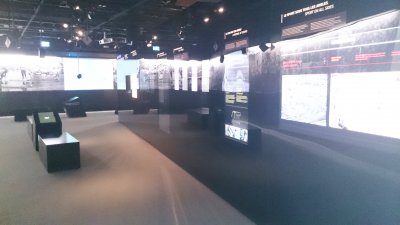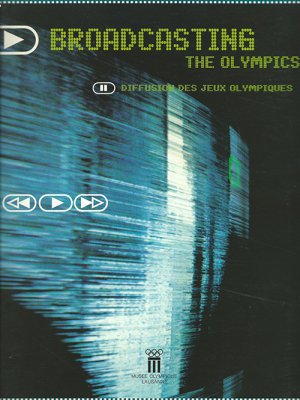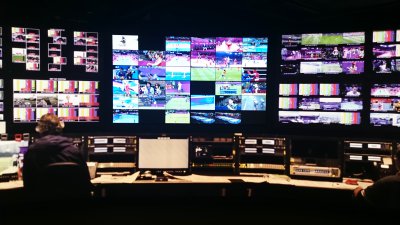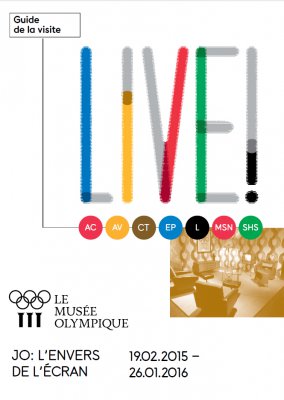Review
Live! An audiovisual history of the Olympic Games
Jesús Castañón Rodríguez (*) (Idioma y Deporte)
Palabras clave: Medios de comunicación. Juegos Olímpicos. Lengua. Historia.
Key words: Mass media. Olympic Games. Language and jargon. History.
THE OLYMPIC MUSEUM: The Olympic Games: Behind the screen. Lausana, 19-2-2015 /26-1-2016.
From 19 February 2015 to 26 January 2016, the Olympic Museum of Lausanne plays host to the temporary exhibition Live!
With the American Jim Owens (Ashbury University) as curator, and in collaboration with Olympic Broadcasting Services, the École Polytechnique Fédérale of Lausanne and Omega Timing, Bienne/Corgémont, the exhibition traces a route through the audiovisual history of the Olympic Games in the 20th and 21st centuries.

Introducción
This interesting journey begins with a review of the television and radio memories of sportsmen and women and journalists, the section of the Olympic Charter regarding the broadcasting of the Olympic Games and an interactive screen where visitors can test their prior knowledge by answering a set of multiple-choice questions. After an emphasis on the role of the media as an accelerator of the history of sport and an arena in which everybody wins since the whole planet has become a stadium, we are invited to set out on this singular adventure.
Ears, on your marks
The second major block is dedicated to the radio, and it describes the different technical breakthroughs incorporated in the summer and winter Olympic Games held in 1924 in Paris, in 1928 in Saint Moritz, in 1936 in Berlin and Garmisch-Partenkirchen, in 1948 in London, in 1960 in Rome and the constant innovations introduced between 1964 and 2014 in Innsbruck and Sochi.
All of this constitutes a panorama which is complemented by press passes, old wireless receivers, photographs and videos of the most important moments described by the commentators, together with various interactive screens that present well-known Olympic voices from all eras via access to their biographies and to audio archives.

Eyes, get set
The third part centres on the history of the Olympic Games in the cinema and on television.
Special attention is given to the pioneering work of the cinema newsreels and the presence on television of the summer Olympics from 1936 and the winter Olympics from 1956.
A section is dedicated to three pioneers and the significance of their contributions. This is the case of the German filmmaker Leni Riefenstahl, with the montage and editing of images, the American Roone Arledge with the drama of images and his eagerness to turn sport into a prime-time spectacle, and the Spaniard, Manuel Romero, in the digital age with the high definition image, digital technology and live broadcasts in 3D. Romero, who is employed by Televisión Española, was the curator of the exhibition Broadcasting the Olympics which was hosted by the Olympic Museum of Lausanne from 20 October 1998 to 18 April 1999.


The exhibits present a chronology of the most important milestones for audiovisual progress in the broadcasting of the Olympic Games: the use of the video recorder, colour, slow motion, the coverage of all the trials, the recording of the whole marathon race without interruptions, the demise of the use of films for recording, satellite transmissions, the first complete edition of the Olympic Games in 2002, the first edition on Internet in 2004, the use of HD image and surround sound, the change of production for digital platforms…
These data are illustrated by two examples. The first example is the case of the improvements experienced between 1960 and 2012 in the broadcasting of athletics, thanks to the evolution of mono, stereo and surround sound to generate an enveloping effect and also to the use of explanatory graphics with all kinds of data, the stability of the image and the automation of filming and the use of a multi-camera technique where one camera is used to follow the race live and this is complemented by another eleven cameras that provide more angles of vision and allow a detailed analysis.

And the second example is provided by the explanation of the processes used on 29 July 2012 when, between three and four o” clock in the afternoon, 33 trials were covered in 20 different sports. A real landmark thanks to the sound recorded by different types of microphone (contact, studio, directional and boundary), the image filmed by different kinds of camera (steadicam, divecam, Q-ball, waterproof camera, Polecam, bow camera, mini x track, camcat camera, hard camera) and the production work performed in a lorry.

This panorama is completed with a description of the organisations responsible for producing and distributing the signal involved in the process: the OBS or Olympic Broadcasting Services and the IBC or International Broadcast Centre in the production and distribution of the international signal in an objective and impartial manner; the customisation of the signal for each country via their broadcasting channels with their own commentators who provide modulation to add the finishing touch with a local focus. A space is dedicated to a table showing the broadcasting companies of different countries, with the voices of representatives of several of these offering their memories and commenting on the main challenges they face when scheduling and preparing a made-to-measure product.
Global mega-event, go
The fourth major centre of interest offers a reflection on the 21st century, a new era that allows every consumer to become a broadcaster thanks to the new digital platforms in which the signal is included and which allow live, à la carte connection to trials and statistics, with no time limits and no frontiers.
Al of this augurs a future marked by technology, applied with commercial criteria. First, owing to the innovations in the image provided by 3D, HD, HFR and HDR systems and the use of the panoptic camera that films in real time while rotating 360 degrees. And second, by the measurement of the impact of the virtual Olympic community thanks to programmes of the École Politecnique Fédérale of Lausanne that classify the messages of the social media according to emotions, measure popularity curves by the number of tweets and by the direction of feeling and organise all the data in explanatory graphs to discover the sentiment, impressions and experience of the Olympic Games.
Conclusión
Live! Is an exhibition that allows visitors to participate actively, to test their previous knowledge, demonstrate their commentating skills in cycling trials and canoe slalom and to offer their personal opinion regarding the broadcasting of the Olympic Games.
|
Portada de la guía |
The exhibition is a benchmark for scholars, communications faculties, sports fans, language enthusiasts who understand that linguistic commentary is at the service of the image… A thirteen-page guide is available for visitors, designed as an educational document and available in the Teaching Resources section of the website Olympic.org. Live! is not just a history of the evolution of the Olympic Games on radio and television, it provides all the details of a broadcast from the simple fact of reporting to an enveloping experience that places the spectator in the midst of the action. It is a history of sport, communication and the work that goes on behind the scenes. |
__________
(*) Jesús Castañón Rodríguez is a teacher and writer. Winner of the Juan Antonio Samaranch Sports Poetry Prize (Premio de Poesía Deportiva), he has collaborated with the Olympic Studies Center José Benjamín Zubiaur (Villa Mercedes, San Luis, Argentina) and the Olympic Studies Center at the University of Oviedo (Oviedo, Asturias, Spain) in various activities and exhibitions.

